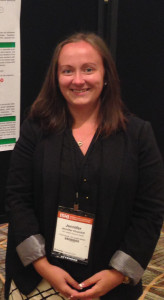Traditional sequencing of the mitochondrial genome in forensic labs has been limited largely to hypervariable regions (HVI and HVII) of the control region due to the high density of sequence variants and limitations with Sanger-type sequencing (STS) methodology. Massively parallel sequencing (MPS) of the entire mitochondrial genome offers forensic DNA analysts an alternative to STS. Sequence data of the entire mitochondrial genome can increase discrimination power, and the increased resolution and quantitative nature afforded by MPS technologies allow for detection of heteroplasmy levels at each nucleotide position. These attributes provide avenues for potential mixture interpretation.
Submitted by: Jennifer Churchill, UNTHSC
A large multiplex, short-amplicon system was developed for sequencing the entire mitochondrial genome on the Ion PGM™ and Ion S5™ MPS platforms. The Applied Biosystems™ Precision ID mtDNA Whole Genome Panel (Thermo Fisher Scientific) is comprised of two multiplexes each containing 81 primer pairs that generate amplicons that are ≤ 175 bps in length and span the entire mitochondrial genome in a tiled, overlapping manner.
To date, we have sequenced the mitochondrial genomes of over 100 reference samples, including African American, US Hispanic, US Caucasian, and Asian individuals, which were amplified with the Precision ID mtDNA Whole Genome panel and sequenced on the Ion PGM™ and Ion S5™ Systems. Serial dilutions of input DNA amounts ranging from one ng to one pg for three control samples were analyzed. Challenged samples, including bones, aged buccal swabs, and hair shafts, and mixture samples were sequenced to evaluate the Precision ID mtDNA Whole Genome System’s success with casework-type samples.
Performance metrics for the mitochondrial genomes of the reference samples indicated accurate and reliable data had been produced. Haplotype calls for overlapping samples were concordant with mitochondrial genome data previously generated by long PCR on the PGM and on the MiSeq. While nominal amplicon dropout or low-performing amplicons were seen in 14 samples, 99 percent of the base-pairs sequenced had a read depth of 5X or greater. Ninety-six percent of the base-pairs sequenced had a read depth of 50X or greater. Average coverage across the mitochondrial genome for these samples ranged from 259X to 8,579X. Strand balance calculations indicated reads were generated from both strands of the DNA. Average noise across the mitochondrial genome ranged from 0.002 percent to 9.03 percent.
A dilution series ranging from one ng to one pg of input genomic DNA illustrated the sensitivity of detection for this multiplex. Haplotype concordance across the dilution series was assessed, and the overall success rate was exceedingly high. A variant was considered “dropped out” if coverage at that position was less than 10X, and results showed no incorrect SNP calls at positions with coverage ≥10X. Additionally, successful analysis of both challenged samples (including bones, aged buccal swabs, and hair shafts; and mixture samples demonstrated the potential that this panel offers for analysis of casework-type samples. For the mixtures, the major contributor’s haplotype was accurately identified with nuclear DNA ratios of 1:1, 1:5, and 1:10 (minor contributor:major contributor).
Could whole mitochondrial genome analysis by MPS become routine in forensic laboratories? Share on X
Overall, results indicated robust and accurate data can be generated. A sensitivity of detection comparable to current CE technologies was illustrated. Successful analysis of casework-type samples, including challenged and mixture samples, was demonstrated. Lastly, when used with the Ion Chef™ System, an efficient workflow now is available which makes the process worthy of consideration for forensic casework. These results are significant for the forensic community as they support the potential for incorporating whole mitochondrial genome analysis by MPS into forensic laboratories for routine mitochondrial DNA analyses and potentially mixture interpretation.
Future work at UNTHSC will involve expanding on current population studies. These studies are imperative for the development of databases with whole mitochondrial genome data that are necessary for calculations of statistical significance. Evaluations of amplicon success and determining limitations of the system with this data will aide in developing appropriate interpretation guidelines. A full validation study of sequencing the entire mitochondrial genome with the Precision ID mtDNA Whole Genome Panel, Ion Chef, and Ion S5 workflow is also underway with the goal of implementing this technology into UNT Center for Human Identification’s Missing Persons lab in the near future.
Jennifer Churchill is a Postdoctoral Research Associate in Dr. Bruce Budowle’s lab at UNT Health Science Center’s Institute of Applied Genetics. Jennifer received her Bachelor of Science degree in Biochemistry from Texas A&M University. Her undergraduate research at Texas A&M involved the application of molecular genetic technologies to the study of population and conservation genetics of the North American bison. Jennifer earned her Ph.D. in Biomedical Sciences specializing in Human and Molecular Genetics at the University of Texas Graduate School of Biomedical Sciences. Her dissertation work focused predominantly on the use of linkage and next-generation sequencing technologies to identify novel autosomal dominant Retinitis Pigmentosa genes. As a postdoctoral research associate, Jennifer’s current research includes the forensic development and application of human identification genetic marker analyses with massively parallel sequencing technologies.
WOULD YOU LIKE TO SEE MORE ARTICLES LIKE THIS? SUBSCRIBE TO THE ISHI BLOG BELOW!



